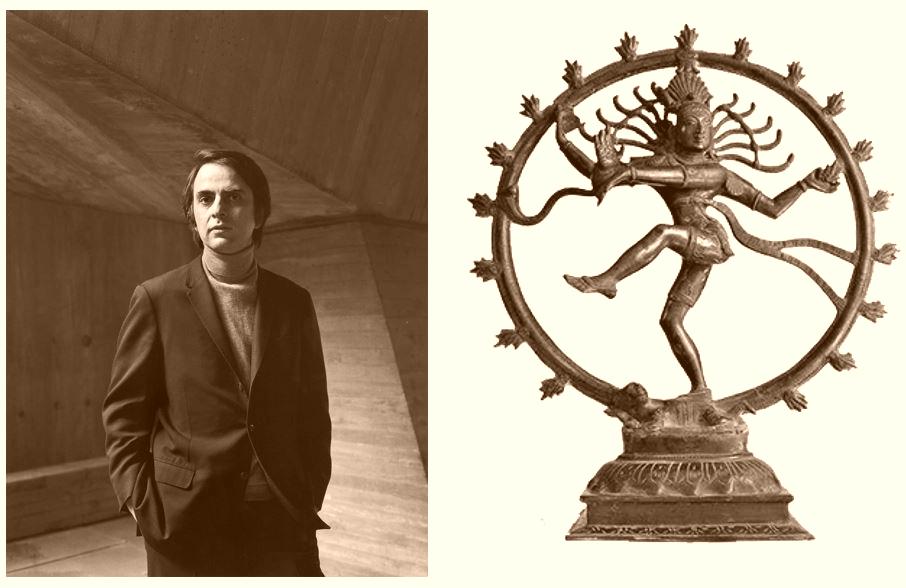On February 14, 1990 when Voyager 1 was at a distance of 6 billion kilometres from earth in outer space, a photograph of earth was taken by it on suggestion of Carl Sagan, the distinguished astronomer and Pulitzer Prize-winning author. The picture showed earth as a dot in the centre of one of the scattered lights. Inspired by the picture Carl Sagan wrote ‘Pale Blue dot’ in which he mentioned that earth is too tiny in comparison to the vast cosmic arena. It is a lonely speck in great enveloping cosmos. The cosmos is a word that intrigues the mind of all children and adult alike. It would be ignorance of someone who considers that he knows everything about it. It’s so deep that many confuse cosmos with the universe.
So, what really is Cosmos? Cosmos is a complex universal set of the universe that encapsulates one or more universe running in an orderly fashion. It includes everything including time, space, matter and the natural laws that govern them. According to Hinduism the Trinity maintains the equilibrium of the universe. It comprises of Lord Brahma who is the creator of universe, Lord Vishnu who preserves it and Shiva who destroys it. In Hinduism belief is that the universe is cyclically created and destroyed. It’s a never-ending cycle. The philosophy is that the universe never came into existence at some particular point, it was always there and it will always be there till eternity. The space and time are cyclical in nature; the universe is also constantly changing.
When the current universe will cease to exist, a new universe will be there to take its place. Interestingly this belief is also central to the scientific “Big Bounce” hypothesis. The big Bounce is a hypothetical cosmological model that suggests that the Big Bang was a result of the collapse of some previous universe. Physicists believe that the universe goes through a cycle of contraction and expansion. The main idea is that as the density tends to infinity the behaviour of quantum foam changes resulting in change of physical constants such as speed of light. The quantum foam in quantum theory is the foundation of fabric of universe. However, the theory does not explain the contraction of current expanding universe.
The two form of dance associated with Lord Shiva are Lasya and Tandav. The Lasya is associated with the creation of the universe while Tandav is related with the destruction of the universe. The demon on which the Shiva dances is symbolism of ignorance while the flames manifest the universe. The snake coiled around his waist symbolizes kundalini which is a form of energy that is said to be located in the base of spine of every individual.
It is believed that by practicing yoga, meditation and other spiritual activities the energy coiled in spine can be unlocked and path spiritual enlightenment be opened. Also, Lord Shiva has four hands in which the upper right hand holds Damaru which symbolizes the sound originating during creation of universe. The upper left hand has fire that symbolizes destruction. The second left hand symbolizes liberation and the second right hand symbolizes state of fearlessness. In 2004 a Nataraja statue was placed in Center for Research in Particle Physics (CERN) in Geneva. It was gifted by Indian government to the research centre celebrating its long association with India.
Carl Sagan was so fascinated by Hinduism and Hindu cosmic philosophy that he co-authored COSMOS, a TV series designed for the purpose of space exploration. A part of this series was shot in India and Carl Sagan went there to shoot part of this series.
It was so successful that it was broadcasted to Soviet Union and People Republic of China. He himself believed in the billion-year time-scale of Hindu cosmology. In Hinduism the scale varies from normal day and night to day and night of Brahma that is of 8.4 billion years. The earth itself is 4.6-billion-years-old according to scientists. The ancient religion has solved queries that were unanswerable by the western researchers. It synergizes science and spirituality beautifully. While some religions like Christianity opposed Science, and persecuted those who preached it; there is no single incident of anyone persecuted in the name of Hinduism because of scientific beliefs. To this day, Hinduism has the capacity to solve unsolved puzzles but one must be ready to delve too deep and keep open mind to find the answers.
